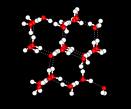The Physics of Ice
Needless to say, without the special properties of ice, hockey just wouldn't be hockey. Ice as we all know is slippery, but why is it slippery? there are a few theories as to why skaters can move so well on the ice.
Theory 2: Another theory is that of frictional heating and melting. This is where the ice under the skate melts due to the friction from the skate moving over the ice. While there is some friction from skating, there is not enough to melt the ice sufficiently to give us the slick surface.
Theory 1: While it is widely believed that ice is slippery due to a thin layer of water on the ice's surface. This theory believes that the layer of water is from pressure melting. followers of this theory believe that as the skater's skate slides over the ice, the weight from the player is concentrated on the skate blade. This increases the pressure on the ice and lowers the freezing point causing the ice to melt and the skate to slide. How ever, the average sized hockey player (93kg) even with gear can only produce half the pressure on the ice that is needed to lower the ice freezing point enough for this theory to be valid.
Theory 3: This theory talks about a layer of quasi-fluid water. This water is on the surface of the ice but is only partially frozen much like a slush. Since this layer is prevalent even on ice that is extremely far below 0 degrees c, this seems to stand out as the reason that ice is slippery. This layer exists on ice as cold as -250 degrees c.


